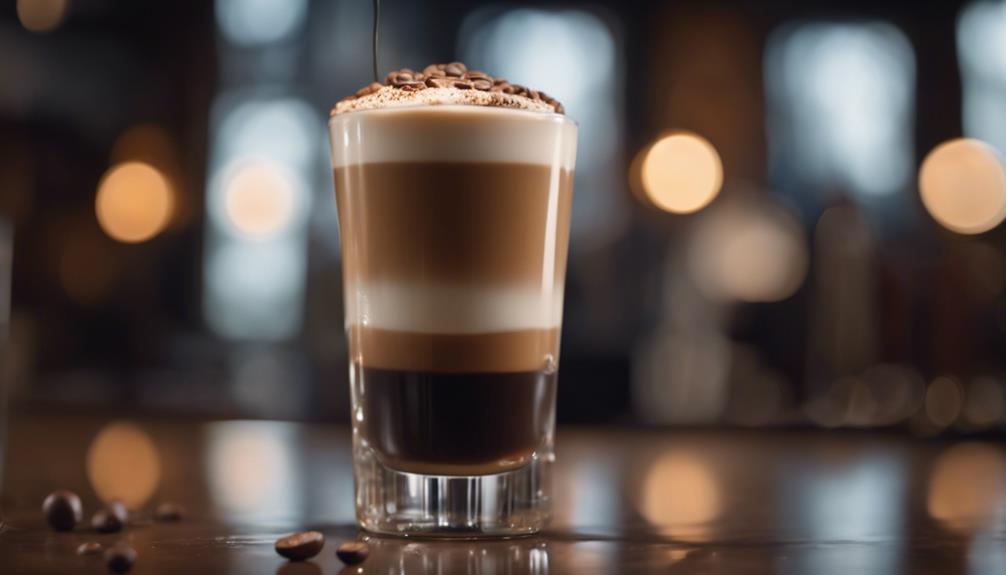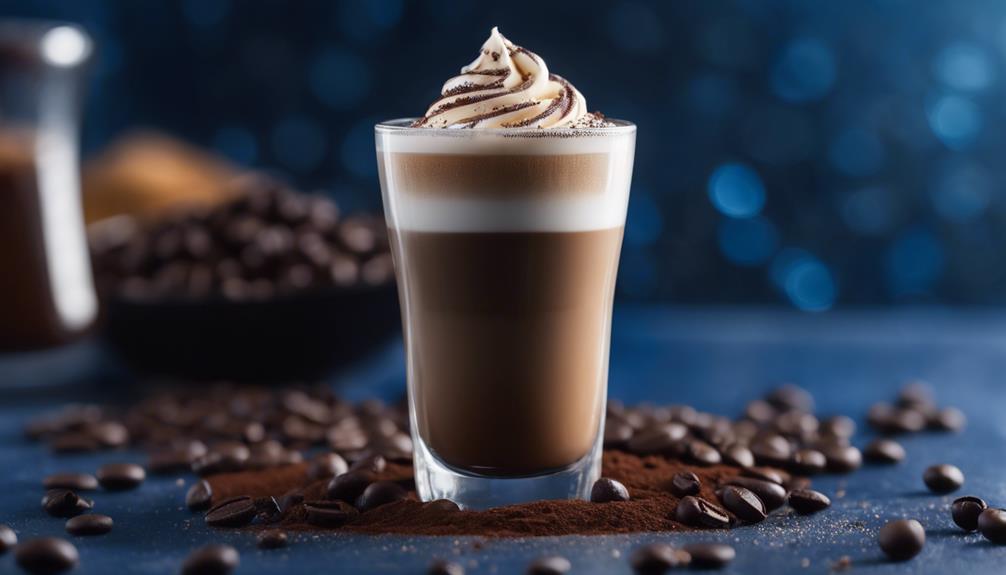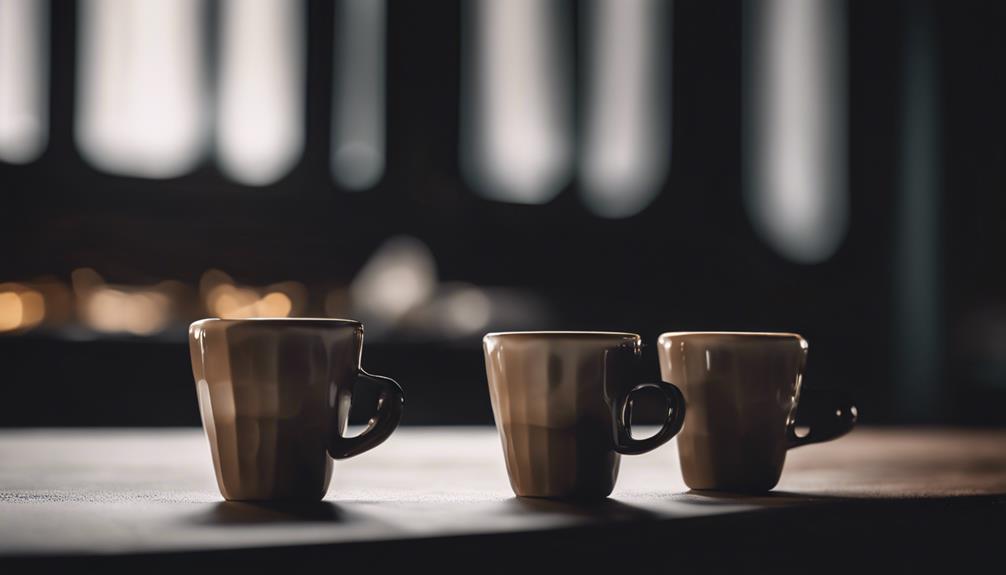In espresso martinis, you will find a combination of vodka, coffee liqueur, freshly brewed espresso, and simple syrup, incorporating alcohol, coffee, and sweetness. Vodka enhances the flavor, while coffee liqueur adds complexity. Freshly brewed espresso contributes a strong flavor, and simple syrup balances out the sweetness. This cocktail offers a sophisticated mix of bitterness and sweetness, with distinct coffee flavors. Enjoy it over crushed ice, try different beans for garnish, and experiment with variations such as milk liqueurs. These details give you a taste of the world of espresso martinis, where flavors blend together seamlessly for a delightful drinking experience.
Key Takeaways
- Espresso Martinis contain vodka, coffee liqueur, freshly brewed espresso, and simple syrup.
- Vodka enhances taste, coffee liqueur adds depth, espresso provides bold flavor, and simple syrup balances sweetness.
- The harmonious blend creates a complex cocktail with bitter and sweet notes.
- Variations include experimenting with liqueurs, sweetness levels, and garnishes.
- Serve chilled over ice and pair with desserts for a versatile and elegant drink.
Ingredients
When making Espresso Martinis, the key ingredients typically include vodka, coffee liqueur, freshly brewed espresso, and simple syrup. Vodka provides the alcoholic kick in the cocktail, while the coffee liqueur, like Kahlúa, infuses a rich coffee flavor into the mix.
The freshly brewed espresso adds a bold and aromatic element, enhancing the drink's coffee essence. Essential syrup plays an important role in balancing out the bitterness of the espresso and adding a touch of sweetness to the overall flavor profile.
Together, these ingredients create a harmonious blend of alcohol, coffee, and sweetness that defines the classic Espresso Martini. The coffee liqueur not only contributes to the drink's taste but also gives it a luxurious depth that coffee enthusiasts appreciate. Essential syrup, with its ability to mellow out strong flavors, ensures that the cocktail is well-rounded and enjoyable to a wide range of palates.
Vodka
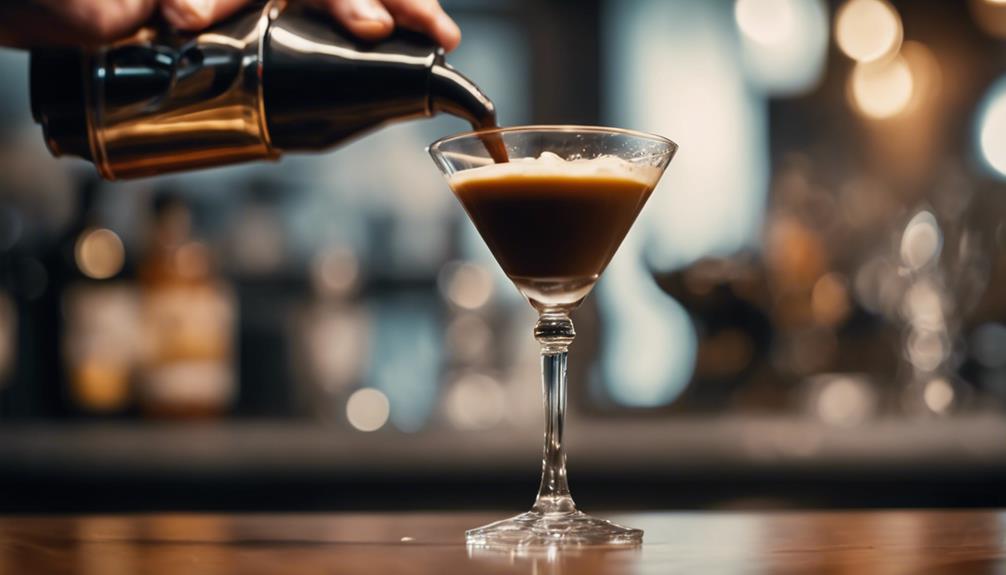
To craft a balanced and flavorful Espresso Martini, the quality of the vodka you choose plays an essential role in enhancing the overall taste experience. Vodka, a key component in Espresso Martinis, provides the necessary alcohol base for the cocktail. Its neutral flavor profile is vital in harmonizing the robust coffee and liqueur flavors present in the drink. Opting for a high-quality vodka is paramount as it can elevate the entire drinking experience.
The vodka's role in an Espresso Martini goes beyond just adding alcohol; it helps create a smooth and well-rounded cocktail that allows the coffee and liqueur to shine. When mixed with the caffeine-infused elements of the Espresso Martini, the vodka serves as a bridge between the alcohol and coffee flavors, ensuring a satisfying and balanced combination. Therefore, selecting a premium vodka for your Espresso Martini is key to achieving a delicious and well-balanced cocktail.
Coffee Liqueur
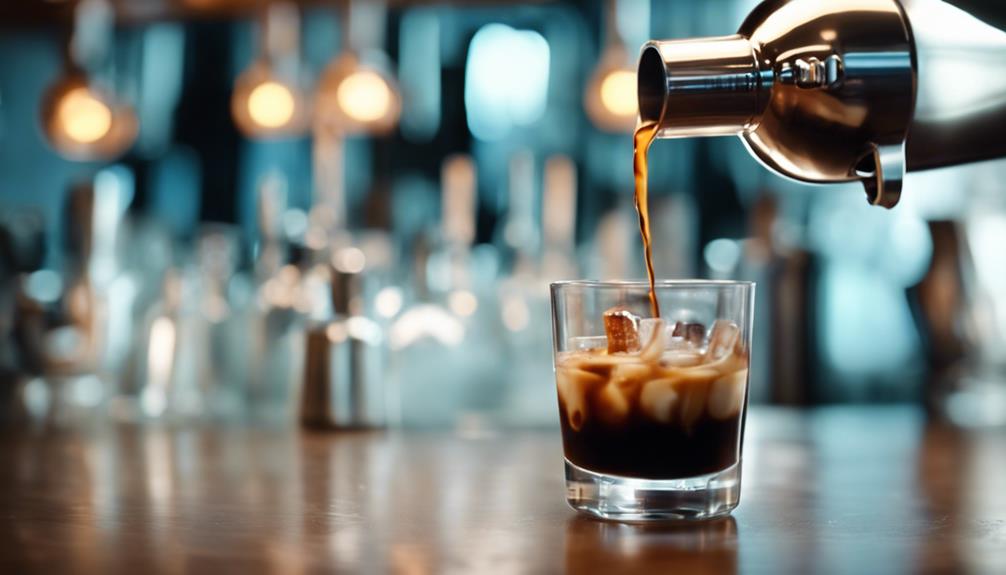
The richness of Coffee Liqueur, like Kahlúa, enhances the flavor profile of Espresso Martinis, providing a delightful coffee essence and sweetness. Coffee liqueur plays an important role in defining the character of this cocktail.
Here are some key points about coffee liqueur in Espresso Martinis:
- Kahlúa, a Mexican coffee-flavored liqueur, is a popular choice that contains rum, sugar, vanilla bean, and arabica coffee.
- Tia Maria is another coffee liqueur option that can introduce depth and complexity to the cocktail.
- The coffee liqueur is essential for elevating the coffee taste and harmonizing the vodka in an Espresso Martini.
- Experimenting with different coffee liqueurs or even substituting with alternative flavors can lead to unique variations of the classic Espresso Martini.
- The quality and type of coffee liqueur used can have a significant impact on the overall taste and experience of the cocktail.
Freshly Brewed Espresso

Freshly brewed espresso plays a vital role in crafting the bold and flavorful essence of Espresso Martinis. When preparing this classic cocktail, it's essential to use a quality espresso shot, typically around 1 ounce in volume, to ensure a balanced and robust coffee flavor. Chilling the freshly brewed espresso in the freezer briefly before mixing it into the cocktail helps maintain its temperature and enhances its overall taste profile. In a pinch, cold brew concentrate can be a suitable substitute for freshly brewed espresso, although it may slightly alter the drink's flavor profile. Remember, the strength and quality of the espresso you use significantly impact the final taste and aroma of your Espresso Martini. Choose your espresso wisely to ensure a delightful and satisfying cocktail experience.
| Freshly Brewed Espresso | Espresso Shot | Cold Brew Concentrate |
|---|---|---|
| Rich and robust flavor | 1 ounce | Suitable substitute |
| Chilled for freshness | Balances cocktail strength | Alters flavor slightly |
| Quality is crucial | Influences taste and aroma | – |
Simple Syrup
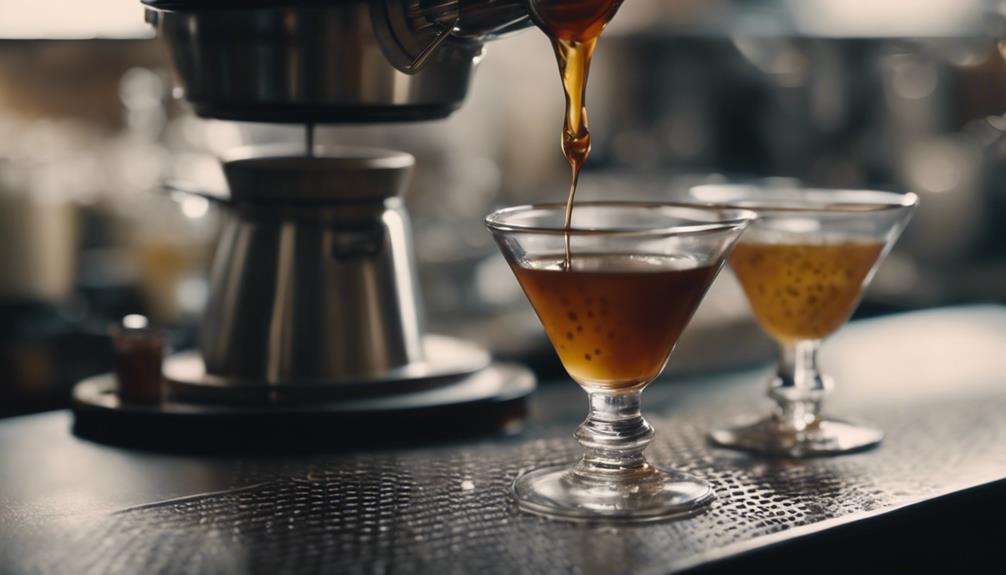
Simple syrup, a common sweetening agent in cocktails like the Espresso Martini, is made by boiling equal parts sugar and water until the sugar dissolves. When preparing an Espresso Martini, simple syrup plays a vital role in achieving the perfect balance of flavors. Here's what you need to know about using simple syrup in your cocktail:
- Simple syrup is a key ingredient in the Espresso Martini, helping to mellow and harmonize the intense flavors of coffee and vodka.
- The equal parts sugar and water in simple syrup guarantee a consistent level of sweetness throughout the drink.
- Adjust the amount of simple syrup according to your taste preferences; some may prefer a sweeter cocktail, while others may opt for a less sweet version.
- Properly balanced simple syrup enhances the overall drinking experience of the Espresso Martini.
- Having simple syrup readily available in your bar setup is essential for creating classic cocktails like the Espresso Martini.
Flavor Profile
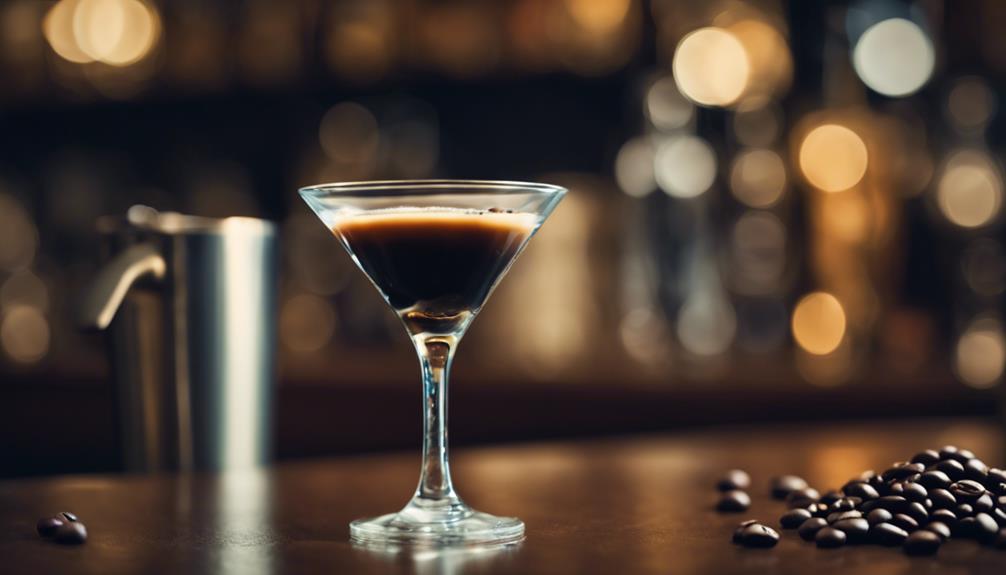
Espresso Martinis strike a delicate balance between bitterness and sweetness, creating a complex flavor profile.
The prominent coffee notes add depth and richness to each sip, giving the cocktail its signature taste.
As you take a sip, you'll notice the intertwining flavors of coffee, sweetness, and a subtle touch of alcohol, creating a harmonious blend that tantalizes your taste buds.
Bitterness Vs. Sweetness
Achieving the ideal balance between bitterness and sweetness is essential for crafting a harmonious flavor profile in Espresso Martinis. When preparing this iconic cocktail, the interaction between the espresso's bitterness and the sweetness of ingredients like coffee liqueur and simple syrup plays a vital role in defining its taste.
Here's how these elements work together:
- Espresso: The bitterness of the espresso contributes a bold and intense flavor to the drink.
- Coffee Liqueur: Varieties like Kahlúa add sweetness and complexity to the cocktail.
- Simple Syrup: This ingredient is used to temper the bitterness of the espresso, resulting in a smoother taste.
Balance is crucial in finding the perfect equilibrium between the bitter notes of the espresso and the sweet components to create a well-rounded Espresso Martini. The final taste of the cocktail hinges on achieving the right blend of bitter and sweet elements.
Coffee Notes Prominent
To understand the flavor profile of Espresso Martinis, consider how the prominent coffee notes play a central role in defining the cocktail's rich and bold taste.
The infusion of freshly brewed espresso in Espresso Martinis delivers a robust coffee flavor that harmonizes with the alcoholic elements, creating a luscious and indulgent experience for coffee lovers.
The coffee essence adds depth and complexity to the cocktail, appealing to those who appreciate the nuances of a well-crafted coffee drink.
Whether made with a shot of espresso or a splash of cold brew concentrate, the type of coffee used can influence the final flavor profile of the drink, catering to different preferences.
The marriage of coffee's bitterness with the sweetness of the liqueurs and the vodka's kick results in a well-balanced concoction that has gained popularity among cocktail enthusiasts seeking a sophisticated yet approachable beverage option.
Preparation Method
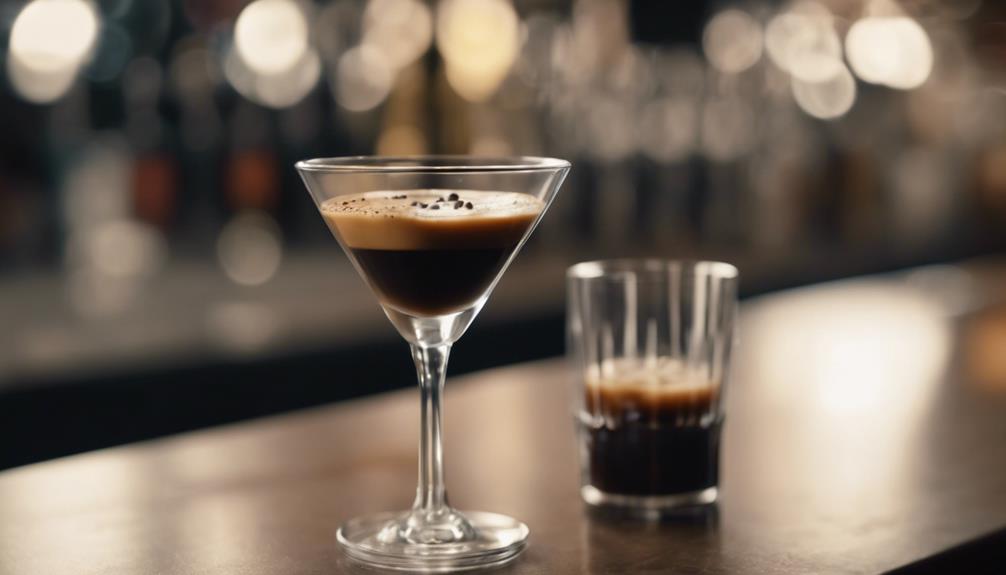
For a perfectly crafted Espresso Martini, start by combining vodka, coffee liqueur, freshly brewed espresso, and simple syrup in a cocktail shaker with ice.
Here are the steps to prepare this delightful cocktail:
- Shake: Once all the ingredients are in the cocktail shaker, shake the mixture vigorously until well-chilled. This process helps create a frothy texture on top of the drink.
- Cocktail Shaker with Ice: The ice in the shaker not only chills the drink but also helps dilute it slightly for a perfectly balanced cocktail.
- Espresso Coffee: The freshly brewed espresso is a key ingredient that provides the rich and robust coffee flavor in the Espresso Martini.
- Martini Glass: After shaking the mixture, strain it into a martini glass to serve. The elegant presentation in a martini glass adds to the overall experience.
- Garnish: To finish off, garnish the Espresso Martini with three coffee beans. This final touch not only enhances the presentation but also adds a hint of aroma to the drink.
This preparation method guarantees a perfect balance of coffee flavor, alcohol, and sweetness in every sip of the Espresso Martini.
Serving Suggestions
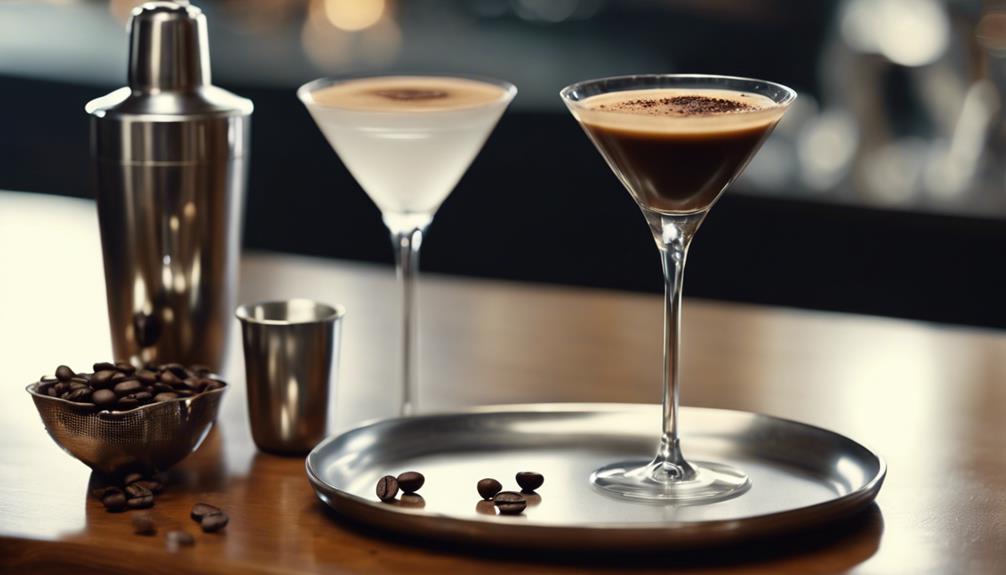
When serving Espresso Martinis, consider pairing them with complementary desserts for a delightful after-dinner experience.
The classic combination of coffee and vodka in an Espresso Martini blends perfectly with rich desserts like Tiramisu or Chocolate Cake. This pairing enhances the flavors of both the cocktail and the dessert, creating a satisfying and indulgent treat for your guests.
For a invigorating twist, serve your Espresso Martinis over crushed ice to add a new dimension to the classic recipe. Controlling the sweetness level of the cocktail allows you to tailor it to your preferences while exploring different types of coffee beans for garnishing can elevate the presentation.
Whether enjoyed at social gatherings or as a sophisticated dessert alternative, Espresso Martinis offer a versatile and elegant option for those looking to combine the bold flavors of coffee with the smooth kick of vodka.
Variations
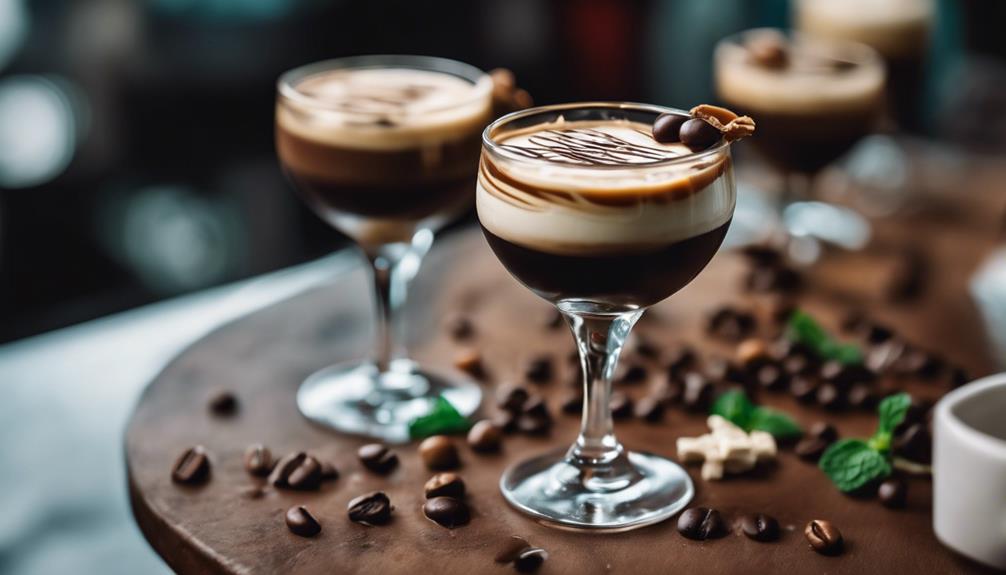
When it comes to Espresso Martinis, there are numerous ways to switch things up.
You can play around with flavors by using different liqueurs or adjusting the sweetness levels.
Experimenting with various garnishes and ingredient ratios can elevate your drink to suit your taste preferences.
Flavor Variations
To enhance your Espresso Martini experience, consider customizing the flavor with various milk or cream liqueurs. Experiment with adjusting the sweetness level to cater to your taste preferences.
Incorporate different types of coffee liqueurs to add unique and diverse flavor profiles to your cocktail. Enhance the drink by adding garnishes like chocolate shavings or flavored syrups for an extra burst of flavor.
Tailor your Espresso Martini further by trying out different garnishes such as cinnamon sticks or orange twists to create a personalized touch.
Ingredient Substitutions
Consider enhancing your Espresso Martini by exploring various ingredient substitutions to create unique flavor variations. One way to switch up your drink is by replacing Kahlua with Tia Maria for a similar coffee liqueur taste. Additionally, you can experiment with different types of vodka, whether it's flavored options or premium selections, to introduce new dimensions to your cocktail. Get creative by trying homemade coffee liqueurs or artisanal coffee spirits to tailor your Espresso Martini to your preferences. Adjust the sweetness level according to your taste by varying the amount of simple syrup or using alternative sweetening agents like agave syrup. For a more distinctive twist, infuse your vodka with coffee beans or play around with different types of espresso for added depth of flavor.
| Ingredient Substitution | Description |
|---|---|
| Kahlua | Tia Maria – Similar coffee liqueur taste |
| Vodka | Experiment with flavored or premium options |
| Sweetener | Adjust sweetness with simple syrup or agave syrup |
Frequently Asked Questions
What Is an Espresso Martini Made Of?
An Espresso Martini is made of vodka, coffee liqueur (like Kahlúa), freshly brewed espresso, and simple syrup for sweetness.
The blend of vodka's kick and espresso's caffeine creates a distinctive cocktail. It follows a classic template balancing bitter, sweet, and strong flavors.
You can adjust the vodka and coffee liqueur amounts to suit your taste. Typically garnished with three coffee beans, Espresso Martinis offer a visually appealing touch to the drink.
What Liquor Is Best for an Espresso Martini?
For the perfect Espresso Martini, vodka is your go-to liquor. Its neutral taste lets the coffee flavors shine.
Add some coffee liqueur like Kahlúa for that rich coffee kick with a hint of sweetness. You can get creative with variations, like trying out Tia Maria or homemade coffee liqueurs.
The mix of vodka and coffee liqueur makes a balanced base. Experiment with different coffee liqueur brands to find your ideal sweetness-coffee combo.
Does Espresso Martini Actually Have Caffeine?
It should be noted that Espresso Martinis indeed contain caffeine. The espresso shot incorporated into the cocktail provides the caffeine kick.
This infusion of alcohol and caffeine gives the drink a unique stimulant effect. It's worth mentioning that the caffeine content in an Espresso Martini is akin to that of a regular shot of espresso.
Due to this caffeine presence, it's advisable to limit consumption to about two servings to moderate your intake.
Do All Espresso Martinis Have Kahlúa?
Yes, not all Espresso Martinis contain Kahlúa, a common ingredient known for its sweet coffee flavor.
While Kahlúa is a popular choice adding a distinctive taste, some variations opt for different coffee liqueurs. These alternatives offer unique flavor profiles to the cocktail.
Does the Ingredients in Espresso Martinis Make Them Gluten Free?
Yes, espresso martinis are gluten free. The ingredients in espresso martinis, like vodka, coffee liqueur, and espresso, do not contain gluten. However, it’s crucial to ensure the other components, like flavored syrups or pre-made mixes, are also gluten free to fully enjoy espresso martinis gluten free.
Conclusion
If you're hesitant to try an espresso martini because you're not a fan of coffee, don't worry – the flavors in this cocktail are well-balanced and not overpowering.
The combination of vodka, coffee liqueur, espresso, and simple syrup creates a smooth and rich drink that's perfect for any coffee lover or cocktail enthusiast.
Give it a try and discover a new favorite cocktail that will surely impress your taste buds.
Cheers!
